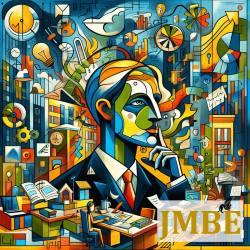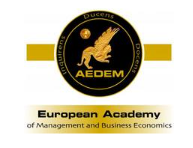Student Response Systems in higher education: A comparative analysis using Wooclap platform in economic courses
DOI:
https://doi.org/10.35564/jmbe.2024.0014Keywords:
Student response system, Innovative education, Wooclap, comparative analysis, questionnarie, higher education, satisfactionAbstract
The introduction of technological tools such as student response systems to dynamise classes in higher education has been increasing in recent years, although often without proper monitoring of their effects. This research aims to analyse the main added value of the use of the Wooclap platform in university education, and whether there are differences in its results depending on the heterogeneous characteristics of the courses and groups in which it is applied. To this end, a comparative analysis has been carried out in three different courses in the field of economics at the University of Valencia. In all three courses, questions were introduced in Wooclap during theory classes. Students in the three courses were given an anonymous survey at the end of the course to evaluate the use of this tool. The students were very satisfied with the tool, highlighting that it helps them to maintain their attention, identify the most important concepts, understand and consolidate them. Furthermore, by means of the Chi-square test, no significant differences were observed in the three groups, from which it can be deduced that beyond the specific characteristics of the course, the profile of the students or the lecturer, this tool can be extrapolated to different contexts and satisfactory results can be expected. The ease of implementation, the possibility of obtaining immediate feedback from students and breaking the monotony of classes are other advantages for lecturers. The conclusions drawn highlight the potential of Wooclap to extend its use in higher education.
Downloads
References
Aguilar, M. (2012). Aprendizaje y Tecnologías de Información y Comunicación: Hacia nuevos escenarios educativos. Revista Latinoamericana De Ciencias Sociales, Niñez Y Juventud, 10(2), 801-811.
Aldalur, I., & Perez, A. (2023). Gamification and discovery learning: Motivating and involving students in the learning process. Heliyon, 9(1), e13135. https://doi.org/10.1016/j.heliyon.2023.e13135
Altwijri, O., Alsadoon, E., Shahba, A. A. W., Soufan, W., & Alkathiri, S. (2022). The Effect of Using "Student Response Systems (SRS)" on Faculty Performance and Student Interaction in the Classroom. Sustainability, 14(22), 14957. https://doi.org/10.3390/su142214957
Boostani, N., Brumelot, C., Ouvrard, L., Stockinger, P., Vigny, P.-J., Tice-Dsirn, U., & Ho, C. (2020). L'enseignement-apprentissage du lexique médiatisé par le smartphone en classe de langue (le cas de la plateforme Wooclap). In Archives Audovosuelles Inalco. https://hal.science/hal-03161986
Braçe-Diko, O., & Garrido-Cumbrera, M. (2022). Utilización de herramientas tecnológicas de dinamización docente en educación superior de asignaturas de geografía. Geosaberes: Revista de Estudos Geoeducacionais, 13(1), 178-185. https://doi.org/10.26895/geosaberes.v13i0.1315
Bruf, D. (2009) Teaching with Classroom Response Systems: Creating Active Learning Environments. Jossey-Bass. ISBN: 978-0-470-28893-1.
Cantero-Chinchilla, F. N., Díaz-Martín, C., García-Marín, A. P., & Estévez, J. (2020). Innovative Student Response System Methodologies for Civil Engineering Practical Lectures. Technology, Knowledge and Learning, 25(4), 835-852. https://doi.org/10.1007/s10758-019-09410-z
Catalina-García, B., & García-Galera, M. del C. (2022). Innovation and hi-tech tools in journalism education. The Wooclap case. Doxa Comunicación. Revista Interdisciplinar De Estudios De Comunicación Y Ciencias Sociales, 34, 19-32. https://doi.org/10.31921/doxacom.n34a1141
Çelik, S., & Baran, E. (2022). Student response system: its impact on EFL students' vocabulary achievement. Technology, Pedagogy and Education, 31(2), 141-158. https://doi.org/10.1080/1475939X.2021.1986125
Charlton, R. (2000). Research: Is an "Ideal" Questionnaire Possible? International Journal of Clinical Practice, 54(6), 356-359. https://doi.org/10.1111/j.1742-1241.2000.tb11922.x
Darling-Hammond, L., Hyler, M. E., & Gardner, M. (2017). Effective Teacher Professional Development. Learning Policy Institute.
https://doi.org/10.54300/122.311
Dhawan, S. (2020). Online Learning: A Panacea in the Time of COVID-19 Crisis. Journal of Educational Technology Systems, 49(1), 5-22. https://doi.org/10.1177/0047239520934018
Dillon, W. R., Madden, T. J., & Firtle, N. H. (1994). Marketing Research in a Marketing Environment. Burr Ridge, Irwin.
Espejo Leupín, R. M. (2016). ¿Pedagogía activa o métodos activos? El caso del aprendizaje activo en la universidad. Revista Digital de Investigación En Docencia Universitaria, 10(1), 16-27. https://doi.org/10.19083/ridu.10.456
Greenwood, P. E., & Nikulin, M. S. (1996). A Guide to Chi-Squared Testing. John Wiley & Sons, Ltd.
Grzych, G., & Schraen-Maschke, S. (2019). Interactive pedagogic tools: Evaluation of three assessment systems in medical education. Annales de Biologie Clinique, 77(4), 429-435. https://doi.org/10.1684/abc.2019.1464
Herrada, R. I., Baños, R., & Alcayde, A. (2020). Student response systems: A multidisciplinary analysis using visual analytics. Education Sciences, 10(12), 348. https://doi.org/10.3390/educsci10120348
Hodges, C. B., Moore, S., Lockee, B. B., Trust, T., & Bond, M. A. (2020). The difference between emergency remote teaching and online learning. In Educause Review. http://hdl.handle.net/10919/104648
Hussain, F. N., & Wilby, K. J. (2019). A systematic review of audience response systems in pharmacy education. Currents in Pharmacy Teaching and Learning, 11(11), 1196-1204. https://doi.org/10.1016/j.cptl.2019.07.004
Ingalls, V. (2020). Students Vote: A Comparative Study of Student Perceptions of Three Popular Web-Based Student Response Systems. Technology, Knowledge and Learning, 25(3), 557-567. https://doi.org/10.1007/s10758-018-9365-0
Kimchi, J., Polivka, B., & Stevenson, J. S. (1991). Triangulation: Operational Definitions. Nursing Research, 40(6), 364-366.
https://doi.org/10.1097/00006199-199111000-00009
Kondo, A., Hayashi, H., & Toyoshi, T. (2023). Project-Based Learning of Mechanical Design Utilizing CAE Structural Analyses. Education Sciences, 13(7), 687. https://doi.org/10.3390/educsci13070687
Kumar, R. M., & Kumar, R. K. (2010). Impact of E-Learning on Teacher Effectiveness. Journal of Educational Technology, 7(3), 63-68.
https://doi.org/10.26634/jet.7.3.1344
Labrador, M. J., & Andreu, M. Á. (2008). Metodologías activas. Universitat Politècnica de València.
Lohr, S. L. (2021). Sampling. Design and Analysis (Third edit). CRC Press.
https://doi.org/10.1201/9780429298899
Marin, J., Brichler, S., Lecuyer, H., Carbonnelle, E., & Lescat, M. (2021). Feedback From Medical and Biology Students on Distance Learning: Focus on a Useful Interactive Software, Wooclap®. Journal of Educational Technology Systems, 50(2), 188-200. https://doi.org/10.1177/00472395211023383
Matas, A. (2018). Diseño del formato de escalas tipo Likert: Un estado de la cuestión. REDIE: Revista Electrónica de Investigacion Educativa, 20(1), 38-47. https://doi.org/10.24320/redie.2018.20.1.1347
McLaughlin, J. E., Roth, M. T., Glatt, D. M., Gharkholonarehe, N., Davidson, C. A., Griffin, L. M., Esserman, D. A., & Mumper, R. J. (2014). The flipped classroom: A course redesign to foster learning and engagement in a health professions school. Academic Medicine, 89(2), 236-243. https://doi.org/10.1097/ACM.0000000000000086
Micaletto-Belda, J. P., & Martín-Herrera, I. (2023). Aprendizaje colaborativo en la Universidad: análisis de una experiencia con una comunidad virtual en Linkedin. EDMETIC, 12(1), 4-20. https://doi.org/10.21071/edmetic.v12i1.14344
Molina-Torres, G., Rodriguez-Arrastia, M., Alarcón, R., Sánchez-Labraca, N., Sánchez-Joya, M., Roman, P., & Requena, M. (2021). Game-based learning outcomes among physiotherapy students: Comparative study. JMIR Serious Games, 9(1), e26007. https://doi.org/10.2196/26007
Molinero Bárcenas, M. del C., & Chávez Morales, U. (2019). Herramientas tecnológicas en el proceso de enseñanza-aprendizaje en estudiantes de educación superior. RIDE Revista Iberoamericana Para La Investigación y El Desarrollo Educativo, 10(19), e005. https://doi.org/10.23913/ride.v10i19.494
Moreno-Medina, I., Peñas-Garzón, M., Belver, C., & Bedia, J. (2023). Wooclap for improving student achievement and motivation in the Chemical Engineering Degree. Education for Chemical Engineers, 45, 11-18. https://doi.org/10.1016/j.ece.2023.07.003
Nagy-Shadman, E., & Desrochers, C. (2008). Student response technology: Empirically grounded or just a gimmick? International Journal of Science Education, 30(15), 2023-2066. https://doi.org/10.1080/09500690701627253
Palazón-Pérez de los Cobos, A., Gómez-Gallego, M., Gómez-Gallego, J. C., Pérez-Cárceles, M. C., & Gómez-García, J. (2011). Relationship Among Application of Active Teaching Methodologies and Learning of University Student. Bordon-Revista de Pedagogía, 63(2), 27-40.
Patton, M. Q. (2014). Qualitative Research and Evaluation Methods: Integrating Theory and Practice (4th ed.). Sage Publications.
Pelegrín-Borondo, J., Sierra-Murillo, Y., García-Milon, A., & Olarte-Pascual, C. (2021). Game of Thrones in Class (Episode 2). ¿Improving Gamification reduces Amotivation and Increases Service Quality in Class? Journal of Management and Business Education, 4(2), 165-182. https://doi.org/10.35564/jmbe.2021.0010
Pescador Vargas, B. (2014). ¿Hacia una sociedad del conocimiento? Revista Med, 22(2), 6-7. https://doi.org/10.18359/rmed.1194
Rahman, M. S., Usman, S., Warren, O., & Athanasiou, T. (2010). Questionnaires, Surveys, Scales in Surgical Research: Concepts and Methodology. In T. Athanasiou, H. Debas, & A. Darzi (Eds.), Key Topics in Surgical Research and Methodology (pp. 477-494). Springer. https://doi.org/10.1007/978-3-540-71915-1_36
Rézio, S., Pedro Andrade, M., & Filomena, M. F. (2022). Problem-Based Learning and Applied Mathematics. Mathematics, 10(16), 2862. https://doi.org/10.3390/math10162862
Robledo, P., Fidalgo, R., Arias, O., & Álvarez, M. L. (2015). Percepción de los estudiantes sobre el desarrollo de competencias a través de diferentes metodologías activas. Revista de Investigacion Educativa, 33(2), 369-383. https://doi.org/10.6018/rie.33.2.201381
Rodriguez Calzada, L. (2021). Learning New Innovative Methodologies Used in COVID-19 Times. Journal of Management and Business Education, 4(3), 338-353. https://doi.org/10.35564/jmbe.2021.0018
Rodríguez Jiménez, C., Ramos Navas-Parejo, M., Santos Villalba, M. J., & Fernández Campoy, J. M. (2019). El uso de la gamificación para el fomento de la educación inclusiva. International Journal of New Education, 3, 39-59. https://doi.org/10.24310/ijne2.1.2019.6557
Sanz, E. J., Vicente-Romero, J., & Prieto, A. (2020). Experiencias de Docencia Virtual en Facultades de Medicina Españolas durante la pandemia COVID-19 (II): Farmacología, Inmunología. Revista Española de Educación Médica, 1(1), 74-81. https://doi.org/10.6018/edumed.429481
Shahba, A. A. W., Soufan, W., Altwijri, O., Alsadoon, E., & Alkathiri, S. (2023). The Impact of Student Response Systems (SRS) on Student Achievements: A University-Scale Study with Deep Exploratory Data Analysis (EDA). Systems, 11(8), 384. https://doi.org/10.3390/systems11080384
Silva Quiroz, J., & Castillo, D. M. (2017). A proposal of a Model for the introduction of active methodologies in Higher Education. Innovación Educativa, 17(73), 115-131.
Stowell, J. R., & Nelson, J. M. (2007). Benefts of electronic audience response systems on student participation, learning, and emotion. Teaching of Psychology, 34(4), 253-258. https://doi.org/10.1080/00986280701700391
Tuttle, G. (2021). Effects of Student Response System in University Foundation Courses. Idaho State University.
UNESCO. (2020a). Beyond Disruption: Technology Enabled Learning Futures.
UNESCO. (2020b). Ensuring effective distance learning during COVID-19 disruption: guidance for teachers. https://doi.org/10.54675/HKXT1562
Universitat de València. (2023). Permanent Training and Educational Innovation Service (SFPIE). https://www.uv.es/uvweb/lifelong-learning-service-educational-innovation/en/educational-innovation/innovation-projects/innovation-projects-1285879014680.html
Wooclap. (2023). Wooclap. https://www.wooclap.com/
Wood, R., & Shirazi, S. (2020). A systematic review of audience response systems for teaching and learning in higher education: The student experience. Computers & Education, 153, 103896. https://doi.org/10.1016/j.compedu.2020.103896
Zdravkovska, N., Cech, M., Beygo, P., & Kackley, B. (2010). Laser Pointers: Low-cost, Low-tech Innovative, Interactive Instruction Tool. The Journal of Academic Librarianship, 36(5), 440-444. https://doi.org/10.1016/j.acalib.2010.06.008
Downloads
Published
How to Cite
Issue
Section
License
Copyright (c) 2024 Journal of Management and Business Education

This work is licensed under a Creative Commons Attribution-NonCommercial-ShareAlike 4.0 International License.
License terms at: https://creativecommons.org/licenses/by-nc/4.0/legalcode




